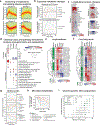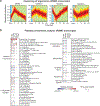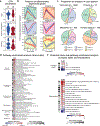Molecular Choreography of Acute Exercise
- PMID: 32470399
- PMCID: PMC7299174
- DOI: 10.1016/j.cell.2020.04.043
Molecular Choreography of Acute Exercise
Abstract
Acute physical activity leads to several changes in metabolic, cardiovascular, and immune pathways. Although studies have examined selected changes in these pathways, the system-wide molecular response to an acute bout of exercise has not been fully characterized. We performed longitudinal multi-omic profiling of plasma and peripheral blood mononuclear cells including metabolome, lipidome, immunome, proteome, and transcriptome from 36 well-characterized volunteers, before and after a controlled bout of symptom-limited exercise. Time-series analysis revealed thousands of molecular changes and an orchestrated choreography of biological processes involving energy metabolism, oxidative stress, inflammation, tissue repair, and growth factor response, as well as regulatory pathways. Most of these processes were dampened and some were reversed in insulin-resistant participants. Finally, we discovered biological pathways involved in cardiopulmonary exercise response and developed prediction models revealing potential resting blood-based biomarkers of peak oxygen consumption.
Keywords: cardiopulmonary exercise testing; fitness; insulin resistance; multi-omics; outlier analysis; peak VO(2); physical activity; predictive analytics; systems biology; time-series analysis.
Copyright © 2020 Elsevier Inc. All rights reserved.
Conflict of interest statement
Declaration of Interests M.P.S. is a cofounder and on the advisory board of Personalis, SensOmics, January, Filtricine, Qbio, Protos, and Mirive. M.P.S. is on the advisory board of Genapsys and Tailai. M.P.S. is an inventor on provisional patent number 62/897,908 “Surrogate of VO2 MAX Test”. K.C. and F.H. are also listed as inventors. E.A.A. is a cofounder of Personalis, Deepcell, and SVEXA and on the advisory board of Apple, SequenceBio, and Foresite Labs.
Figures







References
-
- Agudelo LZ, Femenia T, Orhan F, Porsmyr-Palmertz M, Goiny M, Martinez-Redondo V, Correia JC, Izadi M, Bhat M, Schuppe-Koistinen I, et al. (2014). Skeletal muscle PGC-1alpha1 modulates kynurenine metabolism and mediates resilience to stress-induced depression. Cell 159, 33–45. - PubMed
-
- Arena R, Myers J, Aslam SS, Varughese EB, and Peberdy MA (2003). Technical considerations related to the minute ventilation/carbon dioxide output slope in patients with heart failure. Chest 124, 720–727. - PubMed
-
- Arena R, Myers J, Aslam SS, Varughese EB, and Peberdy MA (2004). Peak VO2 and VE/VCO2 slope in patients with heart failure: a prognostic comparison. Am Heart J 147, 354–360. - PubMed
-
- Arena R, and Sietsema KE (2011). Cardiopulmonary exercise testing in the clinical evaluation of patients with heart and lung disease. Circulation 123, 668–680. - PubMed
Publication types
MeSH terms
Substances
Grants and funding
LinkOut - more resources
Full Text Sources
Other Literature Sources
Medical

